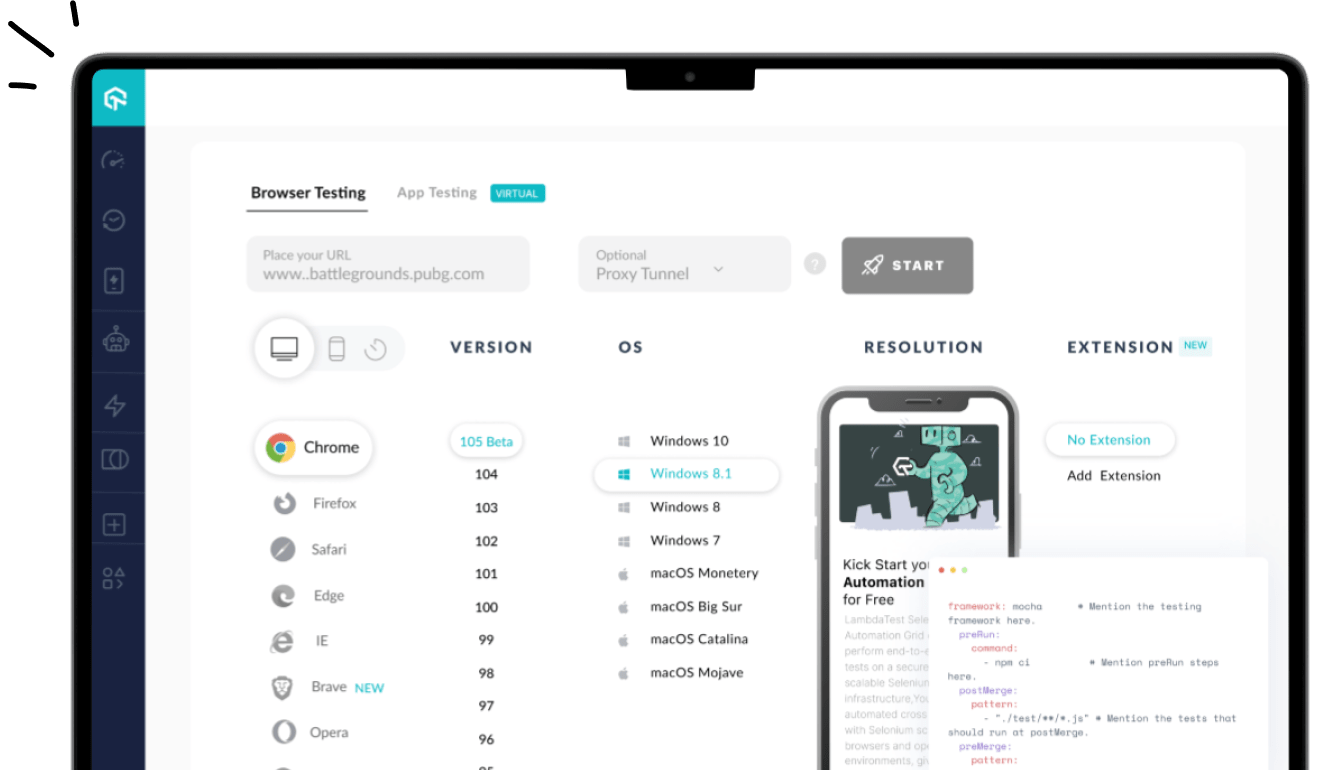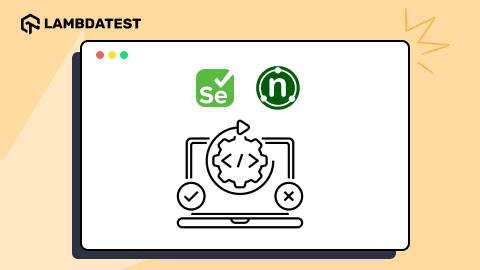Top Selenium C# Frameworks for Automation Testing in 2025
Himanshu Sheth
Posted On: February 7, 2025
![]() 79681 Views
79681 Views
![]() 24 Min Read
24 Min Read
With the ever-increasing number of languages and frameworks, it’s quite easy to get lost and confused in this huge sea of all these frameworks. Popular languages like C# provide us with a lot of frameworks and it’s quite essential to know which particular framework would be best suited for our needs.
This decision of choosing the best-suited Selenium C# framework for automation testing can be a difficult task as a decision has to be made based on the project requirements, in-house expertise, and deadlines.
Everyone has different requirements and thus needs a different solution. In this article we explore the top Selenium test automation frameworks in C#, to help you find your perfect match to your automated browser testing requirements.
Best Selenium C# Frameworks
Check out the top Selenium C# frameworks for efficient and scalable test automation to enhance your testing strategy.
NUnit

NUnit is an open-source Selenium C# framework that is ported from JUnit. The latest version of NUnit is NUnit 3.13.0 which has a host of new features and supports a wide range of .NET platforms.
This Selenium C# framework is widely preferred by C# developers for automated browser testing. NUnit framework is user-extensible, follows a parameterized syntax (or annotation-based syntax), and primarily used for Test-Driven Development (TDD) with C#.
How to Install NUnit Framework?
NUnit test framework can be downloaded from Nuget.org and at the time of writing this article, it had been downloaded more than 126 million times.
To install this Selenium C# framework, execute the following command on the Package Manager (PM) console.
|
1 |
PM> Install-Package NUnit -Version 3.13.0 |
You also have the option of installing the NUnit framework by using the GUI option of Package Manager (PM).
What Makes NUnit a Popular Selenium C# Framework?
NUnit is a preferred Selenium C# framework that is used for automated browser testing. Below are some of the advantages of using the NUnit framework:
- It is a robust and user-extensible test framework.
- Attributes are an important part of the NUnit framework and they are instrumental in speeding up the execution of the test cases.
- The framework is well-suited if you are planning to use Test-Driven Development (TDD) for the test activity.
- NUnit is open-source and the project is witnessing active participation on GitHub.
- Along with automated browser testing, NUnit framework can also be used for unit testing and acceptance testing using the latest version of Selenium.
- Support for parallel test execution on an online Selenium grid reduces the overall test execution time and accelerates the process of automated browser testing.
- Good reporting tools are available that can be used with the NUnit framework.
Areas Where NUnit Framework Can Do Better
There are way too many attributes in the NUnit framework and this often seems confusing. Some of the areas where the NUnit framework could have been better are below:
- The class that contains the tests is under the [TestClass] attribute. Having tests confined under one attribute does not look like a robust approach.
- Instead of having the implementation of test cases/test suites under a particular class, there should have been intelligence built in the test framework so that it could locate the test methods.
- All the tests execute in the same fixture/class whereas the creation of a new instance of the test class for every test is a much better approach.
- The possibility of one test causing other tests to fail is more when using the NUnit framework as all the tests are executed in the same class.
Run NUnit tests with Selenium tests on real desktop browsers online. Try LambdaTest Now!
Is NUnit the Best Selenium C# Framework for You?
You should consider NUnit framework for tasks related to Selenium automation testing and automated browser testing as it is a test framework that has existed for a long time.
Though this Selenium C# framework does not provide much isolation of tests, you could use it since it supports Parallel test execution on the local & remote Selenium grid.
xUnit

xUnit.Net is another popular test framework in C# that is used for Selenium automation testing. ‘x’ in xUnit stands for the programming language for which the test framework is built i.e. JUnit for Java, NUnit for C#, etc. It is a Selenium C# framework that is built by the creators of the NUnit framework.
Instead of planning for incremental changes in the NUnit framework, the creators decided to build a new test framework that is more robust and is built around the community that uses it. Below are some of the reasons why xUnit.net was built:
The latest version of xUnit framework is 2.9.3 xUnit is more robust and extensible when compared to the NUnit framework.
How to Install xUnit Framework?
For installing the xUnit framework and other dependent packages, you have to execute the ‘Install Package’ command on the Package Manager console.
|
1 2 3 |
PM> Install-Package xunit PM> Install-Package xunit.runner.visualstudio PM> Install-Package Microsoft.NET.Test.Sdk |
You also have the option of installing the packages using the Package Manager GUI. To open the NuGet Package Manager, go to ‘Tools’ -> ‘NuGet Package Manager’ -> ‘Manage NuGet Packages for Solution’. Search for the following packages and install each of them:
- xunit
- xunit.runner.visualstudio
- Microsoft.NET.Test.Sdk
What Makes xUnit a Popular Selenium C# Framework?
The xUnit framework is built around the community. Hence, the majority of the shortcomings of the NUnit framework are not carried forward while designing the xUnit framework. Below are some of the reasons why this Selenium C# framework is gaining popularity:
- The framework follows a unique style of testing. Tags like [Test] and [TestFixture] which were an integral part of the NUnit framework are not included in xUnit framework.
- Intelligence is built in the framework as test cases & test suites are not restricted to any particular attribute. The framework is intelligent enough to identify the test methods, irrespective of the location of the methods.
- xUnit provides better test isolation as a new test class is instantiated for each test case. Once the test case execution is complete, the test class is discarded. This reduces the dependency between different test cases and also minimizes/nullifies the possibility of one test causing the other test case to fail!
- It is more user-extensible when compared to the other popular C# frameworks used for Selenium automation testing.
- [Setup] and [TearDown] annotations that normally included the initialization and de-initialization related implementation for the test-cases are not a part of the xUnit framework. This avoids code duplication and makes the code flow more understandable.
- The framework encourages developers & testers to come up with well-designed tests as it makes use of a constructor of the test class for initialization and IDisposable interface for de-initialization.
- This Selenium C# framework has a lesser number of annotations when compared to other C# frameworks. Also, more modern tags like [Fact] and [Theory] ease the process of test case creation, whether the test cases are parameterized or non-parameterized.
- There is the usage of Assert. Throws instead of [ExpectedException] which is much better in handling generic asserts.
- Parallel test execution using a Selenium Grid which is an essential part of automated browser testing can be achieved at the thread level in xUnit.
- It can be used for data-driven testing.
Areas Where xUnit Framework Can Do Better
The xUnit framework has been well-received by the developer & test community. As xUnit is a Selenium C# framework created using intuitive terminology, it is preferred by the folks looking for test frameworks that enable automated browser testing.
Documentation is the only area where the xUnit framework needs some improvement. It is good to see that it is improving over the course of time.
Is xUnit the Best Selenium C# Framework for You?
You should choose the xUnit framework for your project if you are looking at Selenium C# frameworks that are less confusing (with fewer attributes), well-designed and more user-extensible.
There would be a learning curve involved in porting the test code that makes use of the NUnit/MSTest framework to xUnit as it would require a detailed understanding of the framework. The developers of xUnit have a reputation for commitment & evangelism and this is clearly evident from the design of the xUnit framework which keeps the community at the forefront.
If you are looking for a modern C# test framework for automated browser testing, you should definitely give xUnit a spin!
Gauge

Gauge is another popular test automation framework that is used to create readable and maintainable tests using C#. Gauge is open-source and the framework is created by ThoughtWorks Inc. and developers/creators behind the Selenium.
The latest version of Gauge for C# is 1.6.13. It also supports other programming languages including Golang. Gauge is a preferred Selenium C# framework used for the development of BDD (Behavior Driven Development) and ATDD (Acceptance Test Driven Development).
The Gherkin language is used for the creation of feature files and spec files are created using markdown language. As tests are in Markdown, it reduces the effort for test code creation and maintenance.
How to Install Gauge Framework?
To install Gauge framework, you have to visit its official documentation on Installing Gauge.
Once the installation of the Gauge framework is complete, you can use Visual Studio Code with the Gauge extension for continued support and updates. This approach ensures compatibility with the latest versions of Gauge and access to ongoing improvements.
What Makes Gauge a Popular Selenium C# Framework?
Gauge is used for automated browser testing due to a number of reasons; few of them are listed below:
- Availability of a number of templates in the programming language of your choice helps you kick-start the test automation project.
- Command-line tools that makes integration with CI/CD tools much easier.
- Availability of different language runners – C# runner, C# runner (.NET Core), Java runner, Ruby runner, JavaScript runner, Python runner, and GoLang runner. This makes it usable across a wide range of programming languages.
- Flexibility to create your own plugin using Gauge plugin API.
- Integration with cloud based cross browser testing tools like LambdaTest.
- Creation of scalable test cases/test suites through parallel test execution.
- Focus on reporting in different reporting formats (HTML, XML, Flash, etc.) that help in locating and isolating issues in test cases.
- Integration with build management tools like Maven, Cradle, etc.
- Well suited for BDD and ATDD that uses Gherkin for creation of spec files and feature files.
- Excellent documentation to help developers get started with Gauge framework.
As the Gauge framework supports parallel test execution, it is widely preferred for automated browser testing on a remote Selenium Grid.
Areas Where the Gauge Framework Can Do Better
The Gauge framework excels in test automation but could benefit from enhanced reporting capabilities, broader IDE support, advanced data-driven testing, and improved parallel execution. Addressing these areas could further solidify Gauge’s position as a leading test automation framework.
Is Gauge the Best Selenium C# Framework for You?
You should choose Gauge over test automation frameworks if you are looking for a Selenium framework that can be used with different programming languages. If your team is well-versed with Gherkin, you can choose the Gauge framework as it is used for BDD, the framework is updated on a regular basis, and has a growing community.
MSTest

MSTest, also referred to as Visual Studio Unit Testing Framework is the default test framework that is shipped along with Visual Studio. The latest version of MSTest is MSTest V2. The framework identifies tests via annotations/attributes under which the implementation is present. The primary responsibility of annotations in MSTest is to inform the underlying framework about the interpretation of the source code.
MSTest V2 is open-source and has much more powerful features than its predecessor. Project migration from MSTest V1 to MSTest V2 does not require much effort as the entire porting process is seamless. MSTest V2 is hosted on GitHub.
As MSTest V2 is a community-focused Selenium C# framework, it is gaining acceptance and popularity for tests related to automated browser testing.
How to Install MSTest Framework?
Libraries/Packages related to this Selenium C# framework can be installed using Package Manager Console in Visual Studio. In VS Code, launvh Package Manager Console and execute the following on the PM Console.
|
1 2 3 |
PM> Install-Package MSTest.TestAdapter PM> Install-Package MSTest.TestFramework PM> Install-Package Microsoft.NET.Test.Sdk |
Packages for the MSTest framework i.e. MSTest.TestAdapter, MSTest.TestFramework, and Microsoft.NET.Test.Sdk can also be installed by using the NuGet Package Manager.
What Makes MSTest a Popular Selenium C# Framework?
MSTest V2 is widely accepted by the test community which is into Selenium automation testing. Below are some of the salient features of MSTest V2 which makes it a popular framework for automated browser testing:
- Open-source and community-driven focus are the key factors that work in favor of MSTest V2.
- V2 version of MSTest framework comes with cross-platform support i.e. developers can write tests for the .NET framework, .NET Core, and ASP.NET Core on varied platforms like Windows, Mac, and Linux.
- Data-driven testing is possible with the MSTest framework. With a data-driven approach, developers can come up with methods that can be executed a number of times using different input arguments.
- Using in-assembly parallelism features, multiple tests can be executed in parallel thereby reducing the overall execution time.
- The framework is extensible as developers can come up with custom attributes and custom assets using MSTest.
As MSTest framework comes pre-bundled with Visual Studio, many developers prefer using the framework for Selenium automation testing. V2 version of MSTest is much more developer-friendly which is also one of the reasons for the growing popularity of this Selenium C# framework.
Areas Where MSTest Framework Can Do Better
MSTest V2 is comparable with other popular Selenium C# frameworks like xUnit and NUnit. However xUnit has an upper edge as it has fewer annotations which leads to less confusion.
MSTest does not provide adequate test isolation as a new test class is not instantiated for each test case. These can be considered as the strong points of other test frameworks like xUnit.net rather than the shortcomings of MSTest.
Is MSTest The Best Selenium C# Framework For You?
MSTest V2 comes with an interesting set of features like parallel test execution using Selenium Grid, extensibility, community focus, data-driven testing, and much more.
The MSTest framework can also be used without Visual Studio, all you need is a command-line tool named MSTest.exe. Depending on the complexity of the project and skill-set of the team members, you have to choose between MSTest, xUnit, and NUnit framework for the project as each of these Selenium C# frameworks have their advantages and disadvantages.
Golem

Golem is an open-source, object-oriented C# test framework that is available on GitHub as ProtoTest.Golem. Golem was used as an Internal tool at ProtoTest and the good part is that the tool had already been used by a number of ProtoTest’s clients before it was made open-source.
As mentioned by the author Brian Kitchener, Golem is an all in one test automation for anyone who is working in the .NET environment. The tests in Golem are written in Visual Studio. Initially, MbUnit was used for test case development and Gallio for execution but version 2.2.1 of Golem internally makes use of the NUnit framework.
As mentioned by the author Brian Kitchener, Golem is an all in one test automation for anyone who is working in the .NET environment. The tests in Golem are written in Visual Studio. Initially, MbUnit was used for test case development and Gallio for execution but version 2.2.1 of Golem internally makes use of the NUnit framework.
How to Install Golem Framework?
The latest version of Golem is 2.2.1. Golem can be installed by executing the package manager command ‘Install Package
|
1 |
PM> Install-Package Golem -Version 2.2.1 |
What Makes Golem a Popular Selenium C# Framework?
The biggest upside of the Golem framework is that it was extensively used internally at ProtoTest before the code was open-sourced. Below are some of the positives of the Golem test framework:
- The Golem framework is open-source, simple, well-designed, and uses object-oriented APIs.
- It supports a number of test automation tools like Selenium WebDriver, Appium, UIAutomation from Microsoft, and can also be used to test REST services & validate HTTP traffic.
- The framework is much more than Selenium C# framework as it supports different test automation tools.
- Tests are written using industry-standard, ‘page object,’ design pattern
- It makes building clean, robust, reusable and simplifies the process of scale-able automation.
- It has a robust reporting and logging mechanism which can be very useful for isolation of issues.
- It supports data-driven testing as well as parallel test execution using Selenium Grid.
Areas Where the Golem Framework Can Do Better
As Golem supports multiple test automation tools, it can be used for test automation including automated browser testing and Selenium automation testing. Though there is the number of advantages of using Golem for test automation, their number of shortcomings:
- The last update to Golem was on 11/3/2016 due to which the framework is not able to gain much traction.
- To date, 2.2.1 version of Golem has been downloaded only 2820 times. This means that Golem’s latest version is not in use by many developers/enterprises.
Is Golem the Best Selenium C# Framework for You?
The biggest advantage of the Golem framework is that it supports a number of test automation tools, including Selenium WebDriver. Hence, it can be used for Selenium automation testing.
Though the framework was built keeping simplicity and reusability in mind, minimal framework updates can dampen the growth of Golem. Since there has not been much activity on Golem’s Support Group, test automation development using Golem can come to a standstill if you encounter issues when using the framework.
You should choose the Golem framework over other test automation tools only if the goal is to look for test automation frameworks that provide support for multiple automation tools.
Bumblebee

Bumblebee is a Selenium browser test automation framework that can be used for standardized creation of page objects. It can also be used for dynamic web pages. Bumblebee is a .NET layer that is built on top of the Selenium browser automation framework. The latest version of Bumblebee is Bumble 2.0 i.e. 2.1.2.
Bumblebee was built in a manner that each page can be broken down into multiple Blocks and Elements. The classes provided by Bumblebee to model your website into page objects that can be consumed into the automation code. If page objects are well designed, writing the automation code in Bumblebee should be an effortless task.
How to Install Bumblebee Framework?
To install Bumblebee on Visual Studio, create a new project of type ‘Class Library’. Like other Selenium C# frameworks, Bumblebee should also be installed using the Package Manager in VS Code. Execute the following command on the Package Manager (PM) console:
|
1 |
PM> Install-Package Bumblebee.Automation |
Alternatively, Bumblebee can be installed by downloading Bumblebee’s Nuget package.
What Makes Bumblebee a Popular Selenium C# Framework?
The best part about the Bumblebee framework is the design. Bumblebee standardizes the design of page objects and makes the automation scripting easier. Below are some of the core reasons why you should use Bumblebee for activities related to automated browser testing:
- Like other page object models, Bumblebee divides testing into two parts. The page objects model the subject of the testing, and the automation uses the page objects to tell the browser what to do.
- Page objects can be developed at a quicker pace by modeling which parts of the page can be interacted with.
- The automation are driven by IntelliSense.
- There is intense focus on usability as it makes use of standardized UI interfaces.
- This Selenium C# framework is flexible, supports parallelization, and also provides test framework independence.
- As each page is broken down into Blocks and Elements, writing test automation code is a much simpler task with Bumblebee.
- Each browser session is instantiated with a driver environment, specifying how to create the driver for that particular session. Thus you can have multiple environments, such as a local environment (running on your local machine) and a grid environment (running on some remote selenium grid). Hence, Bumblebee can be used for automated browser testing on local as well as remote Selenium grid.
- There is extensive documentation on this Selenium C# framework that can aid developers with automated browser testing.
- Test cases designed using Bumblebee are extremely flexible and takes some of the burdens off of designing blocks for complicated sites.
- There is a separate library for adding Kendo element support for Bumblebee test framework.
Areas Where the Bumblebee Framework Can Do Better
Bumblebee has advantages of a well-designed test framework that makes excellent use of the Page Object Model (POM). This eases the job of test creation and test maintenance.
Though the Bumblebee framework is updated on a regular basis, the documentation seems a bit outdated as it does not contain examples with the xUnit framework which is gaining traction for Selenium automation testing. Also, there are no code samples/snippets demonstrating usage of Bumblebee for parallel test execution, using Selenium Grid, which is a critical aspect in automated browser testing.
Is Bumblebee The Best Selenium C# Framework For You?
The Bumblebee framework has all the right things in place as far as automated browser testing is concerned. The learning curve for getting used to the Bumblebee framework will not be much as it is the .NET layer on top of the Selenium browser automation framework.
If your team is looking for a Selenium C# framework that is built on good design principles, follows Page Object Modelling (POM), supports parallel test execution, and is test framework independent; then you should give Bumblebee a try.
Atata

Atata framework is an open-source C#/.NET web UI test automation framework that is built on Selenium WebDriver. It uses the Page Object Pattern for development. This framework supports .NET Framework 4.0+ and .NET Core/Standard 2.0+. The latest version of Atata is 3.4.0. The project is hosted on GitHub under the Apache License 2.0.
This Selenium C# framework consists of the following concepts:
- Components (controls and page objects)
- Attributes of the control search
- Settings attributes
- Triggers
- Verification attributes and methods
These templates are accessible in Visual Studio’s “New Project” and “New Item” windows under the “Atata” category.
How to Install Atata Framework?
Once a new Atata project is created, the Atata package has to be installed. Along with the base Atata package, dependent packages of Atata are automatically installed. For installing the Atata Package, the following commands have to be executed on the Page Manager Console:
|
1 2 3 4 |
PM> Install-Package Atata PM> Install-Package Atata.Bootstrap PM> Install-Package Atata.Configuration.Json PM> Install-Package Atata.KendoUI |
The same packages can be downloaded from the NuGet Gallery and installed using the Package Manager GUI.
Atata.Bootstrap package is the C#/.NET package containing a set of Atata components for automated web testing/automated browser testing integration with the Bootstrap Framework.
Atata.Configuration.Json is a C#/.NET package for Atata configuration through JSON files.
Atata.KendoUI is a C#/.NET package containing a set of Atata components for automated web testing integration with Kendo UI HTML Framework.
What Makes Atata a Popular Selenium C# Framework?
Atata is a relatively new Selenium C# framework but the overall design based on Page Object Model (POM) and flexibility to use with different .NET engines are the points that make Atata a powerful framework.
Below are some of the key factors that make Atata a framework to watch out for in 2025:
- Atata is based on the Selenium WebDriver and preserves all the features of Selenium WebDriver. As Selenium framework is widely used for automated browser testing, the learning curve involved to learn the framework will be steep.
- As Atata is based on POM, creation and maintenance of test cases/test suites is not difficult.
- Atata can be used with major .NET test frameworks i.e. NUnit, xUnit, SpecFlow, etc.
- Atata works well with Continuous Integration (CI) systems like Jenkins, Azure, DevOps, TeamCity, etc.
- It has built-in reporting logging and screenshot capturing functionality.
- It has more powerful assertion methods and triggers that are useful for component & data verification.
- There are a powerful set of components (inputs, tables, lists, etc.) built-in the Atata framework. Though these components might not be useful for Selenium automation testing, they would be definitely used for data-driven testing.
- There is a feature for multi-browser configurations via fixture arguments.
- This Selenium C# framework is user-extensible. Atata.Bootstrap and Atata.KendoUI packages have a set of ready to use components.
The Atata framework has the right set of powerful features that are useful for automated browser testing.
Areas Where the Atata Framework Can Do Better
Though Atata is not a new test framework, the development of the framework picked up pace. We have to wait for more adoption before commenting on the improvements to the framework. On the whole, it looks a promising automated browser testing framework as it can be used with popular C# frameworks.
The team behind the development of Atata framework has to ensure that the community is updated about the development of the framework else it might lose traction!
Is Atata the Best Selenium C# Framework for You?
The biggest plus point of using the Atata framework is that it can be used with popular test frameworks like NUnit, xUnit, SpecFlow, etc. Since this Selenium C# framework can be used with SpecFlow, it is instrumental for Business-Driven Development (BDD).
ReqnRoll

Reqnroll is an open-source .NET test automation framework that facilitates Behavior Driven Development (BDD) using the Gherkin language. It serves as a .NET port of Cucumber and is based on the SpecFlow framework and codebase.
To install Reqnroll, you can refer to its official documentation.
Is ReqnRoll the Best Selenium C# Framework for You?
If your team is seeking a BDD framework that integrates seamlessly with the .NET ecosystem, supports Gherkin syntax, and offers compatibility with SpecFlow, Reqnroll is an excellent choice. Its open-source nature and active community support further enhance its appeal for .NET developers.
When performing Selenium testing with C# frameworks, ensuring cross-browser compatibility across various environments can be time-consuming and resource-intensive. This is where cloud-based platforms such as LambdaTest come into play, offering the ability to run tests on various browser-OS combinations without the need for complex local environments.
For instance, AI-powered test execution platforms like LambdaTest allows testers to perform automation testing using Selenium with C# on the cloud. Testers can also run tests leveraging different C# testing frameworks such as NUnit, xUnit, MSTest, and more, helping them streamline testing workflows with minimal effort.
Bottom Line
Choosing an ideal Selenium C# test framework should be based on the team’s expertise and prior experience with the framework.
Many test teams are making use of BDD and ATDD as it improves collaboration between the team members and also brings an extra angle on automation testing. In such scenarios, you should choose the best-suited test automation framework for performing the job.
All the Selenium C# test frameworks support parallel test execution but you might encounter issues to get started with it. Hence, look at the community of the test framework before making a final choice.
Do you agree with our picks? Let us know, which is your favorite C# test automation framework. Pick your favorite and tell us the reason why, in the comment section below!
Happy Testing
Frequently Asked Questions (FAQs)
Can I use Selenium with C#?
Yes, Selenium can be used with C# for web automation testing. You can integrate Selenium with C# by using the Selenium WebDriver library and test frameworks like NUnit, xUnit, or MSTest.
Which framework is best for Selenium?
NUnit is widely regarded as one of the best frameworks for Selenium due to its simplicity and strong integration with Selenium WebDriver. xUnit is also popular for its performance and modern features, while MSTest is a good option for Microsoft-based environments.
Got Questions? Drop them on LambdaTest Community. Visit now














